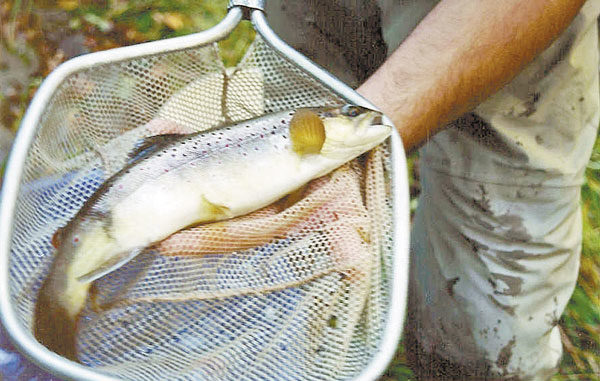
Brook trout have inhabited mountain streams for thousands of years, possibly pre-dating humans. Once, they were the only salmonid found in southern Appalachian streams, and their habitat stretched from the mountains to the Piedmont.
Extensive logging in the late 1800s wiped out much of that habitat. When the brook trout began disappearing in staggering numbers from mountain streams, exotic fish were introduced to provide a “sport” fishery: rainbow trout from the west and later, brown trout from Europe.
Being more aggressive than brook trout, the exotics hogged limited food resources, pushing the brookies farther and farther upstream. Rarely do wild brook trout inhabit the same waters with wild rainbow and brown trout. Despite the intrusions, brook trout endured, albeit in smaller numbers. They survived because they could live in places that neither loggers nor non-native trout could reach.
Old-time trout fishers called brook trout “specks” because of the fish’s unusual markings. Many mountain fishers still refer to brooks as speckled trout, some believing they are a separate species. When you compare a hatchery-raised brook to a stream-raised brook, there is no comparison.
Wild brook trout have wavy, worm-like markings on their olive-green backs, similar to the pattern light makes on a rocky stream bed when the sun is filtered through rippled water. Since most brook trout streams are shallow, the markings, or vermiculations, provide the trout with a natural camouflage, making it difficult for predators such as herons and kingfishers to spot them. On their sides, from head to tail, are red and pale yellow dots surrounded by delicate blue halos. Their bellies are cream colored, and the tips of their dark lower (pectoral, ventral and anal) fins are white. The white-tipped fins are a sure way of identifying a brook trout; it’s a unique feature.
Brook trout actually aren’t trout; they are members of the char family, which includes Dolly Varden, Arctic char, true lake trout, and the rare blueback trout.
Brook trout spawn from late October into November. Depending on the water temperature, eggs hatch in January or February. Tiny fry stay buried in the stream gravel, subsisting on nutrients in the yolk sac until they’re able to forage on their own.
When hooked, brook trout do not make long, tail-dancing runs like rainbow or brown trout. Instead, they dive, tug, and twist, only occasionally popping to the surface. They are fairly easy to catch, much easier than a wild rainbow or brown trout. Place a fly in a riffle or at the edge of a pool, and you’ll immediately get a strike.
Don’t expect a large fish, because brook trout just don’t live long or grow large. The average life span for a wild brook trout is three to five years, and the average size is six to eight inches. A day’s fishing trip will produce more fish in the 4- to 6-inch range, though, than in the 6- to 8-inch range. Occasionally, if you find a nice, deep pool, you may hook a 10- or 11-inch brookie. Savor the moment, for it is a rarity.
Some of the mountain area’s biggest brook trout are in the headwaters of the Tuckasegee River in the Panthertown section of the Nantahala National Forest in Jackson County. The streams, Greenland Creek and Panthertown Creek, consistently produce brook trout 11 inches and larger. Greenland and Panthertown creeks are managed by the N.C. Wildlife Resources Commission under catch-and-release, artificial lures-only regulations. Three other brook trout streams also are managed under these regulations: Flat Creek in the Roy Taylor Forest in Jackson County, and Lower and Upper creeks, tributaries of the South Toe River in Yancey County.
Another excellent wild brook trout fishery is the headwaters of Big Snowbird Creek in Graham County. From the parking lot at the end of Big Snowbird Road, it’s about a 5-mile walk to Middle Falls, where the brook trout section begins. A good trail follows the stream. Brook trout in the 10- to 11-inch range are fairly common in this section.
In the Great Smoky Mountains National Park, brook trout streams once were closed to fishing until biologists determined that fishing pressure had little or no effect on populations. A few wild brook trout streams are still off limits, part of the National Park Service’s efforts to restore certain streams
Before fishing regulations were imposed, mountain fishers often caught brook trout by the sackful because they were considered prime table fare. Brookies still are considered a better “eating” fish than either a brown or rainbow, and, as a result, are widely poached.
Locating native brook trout streams is not difficult; the difficult part is getting to them. Find a map that shows a watershed and look for feeder streams or the headwaters of a primary stream in the watershed. Then start walking. More than likely, you’ll find a streamside trail to take you part of the distance. You may have to bushwhack through briars and thick tangles of rhododendron. You’ll suffer scratches and bruises, but one thing is certain: the rougher the terrain, the fewer the fishers who’ve gone before you. Keep climbing until you find a waterfall or a series of waterfalls. Above the waterfalls is where you’ll find brook trout, places where rainbow and browns can’t reach.
You’ll wonder if all the effort is worth it until you find a pool surrounded by sheer rock cliffs where water cascades over a ledge of mossy rocks. You’ll cast a parachute Adams or a Quill Gordon into the waterspill, and before the fly floats more than few inches, you’ll see a splash, feel a hard tug on the line, and when you land your catch and hold it in your hands, it will take your breath away.




Be the first to comment